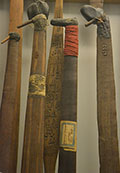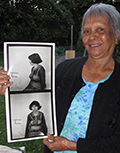
Aboriginal Australia
Vatican and Italian collections
This paper presents an overview of the history of acquisitions of the main Italian and Vatican collections of Australian ethnographic material and explains how they got to be there, with reference to some of the key concerns and differences between the institutions and individuals involved. The way these collections are displayed and interpreted today reveals how they are used to instigate social and inter-cultural dialogue. At a time of increased immigration with people of different cultural backgrounds, the ethnographic collections have taken on a new importance, offering a bridge to educate the community about little known peoples and cultures.

‘Looking past’
The work of Michael Aird
For Aird, ‘history began with the invention of photography’, and his work positions photographs of Aboriginal people as living, relational objects, which exist as part of dynamic relationships within Aboriginal communities and between generations of families. In bringing these to light in exhibitions and books, Aird creates spaces for exchange and enables contemplation of a shared existence that has been too often simplified and trammelled into discourses of subjugation and victimisation.

Slamming the Anthropocene
Performing climate change in museums
The ‘slam’ is a concept that originated with poetry, performance and a competitive spirit. Poets performed their words and audiences voted with acclamation for the winners. The slams were noisy, theatrical and democratic – far removed from ‘high art’ poetry recitation. In November 2014, the University of Wisconsin hosted a different kind of slam, an object-inspired event that brought together artists, filmmakers, scholars and performers to explore ideas around the concept of the Anthropocene, the proposition that the Earth has now left the Holocene and entered a new epoch. This paper explores how, in museums and elsewhere, performance events such as the Anthropocene Slam can be used to explore the possibilities for adaptive strategies in the face of rapid change, allowing objects to explore facets of a bigger story in smaller, playful ways.
